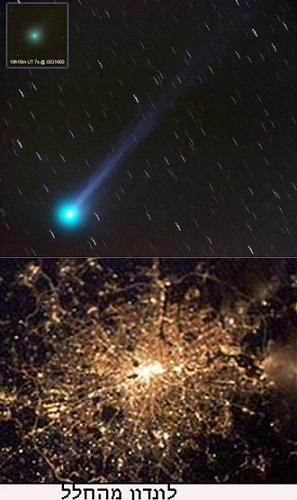Light that originates from electricity - one of the great advantages that technology has given humanity, the concept of pollution is implied as a complete contrast to light and yet there are environmental disadvantages to the abundant light emanating from homes, offices, factories and cities

It is enough to hear the claims of frustrated astronomers that "the light from the ground prevents the possibility of observing the stars, and from year to year the stars "fade". This week a unique greenish comet appeared in our name, it could be seen in the west right after sunset... is it possible? Not exactly, not from residential areas, since the artificial light prevented the possibility of observing the comet.
The importance/need of being able to see stars is equal to the other sights of nature: sun, clouds, rain, moon and the like, without stars (visible) an important factor is missing in the picture of our world. But there is not only a visual disadvantage in light pollution, with all due respect to Edison for inventing the bulb that gives light using a filament, such a bulb is very wasteful in energy, the light is spread everywhere and thus there is waste, moreover - only 5% of the energy that reaches the bulb is converted into light, The other 95% is wasted
According to electrical engineers at "Philips": half of the lighting fixtures in residences are incandescent lamps, and about 20% of the electricity consumption is used for lighting, so the expenditure/waste on lighting is large and according to the "Energy Agency" (IEA) the electricity consumption for lighting in 2030 will increase at 80% In reference to environmental problems such as global warming and lack of energy sources, it is clear that something must be done to reduce waste and reduce light pollution!
Waste can be reduced with simple means such as turning off lights in buildings/houses when light is not needed, "presence sensors" already in use that turn off lights (automatically) when there is no activity in the space, correct and efficient use of daylight to illuminate spaces, simple and easy actions by everyone can lead to a 50% saving in light/energy.
There is of course also savings through technological development: economical bulbs (neon, mercury, etc.) already exist in the market, according to "Philips" engineers, the biggest savings will be through the use of technology / "LED" light-emitting diodes - LED tiny bulbs that are - Light diffusing diodes, those with high energy utilization and being tiny allows them to be "deployed" in efficient lighting systems that direct the light to spaces or points where the light is needed. Philips intends to invest approximately 400 million euros (in the next five years) in finding cost-effective solutions for lighting and preventing light pollution.
Solutions that will replace the incandescent lamp, habits of use and saving, will give us back the possibility to see stars, moreover the expected energy saving will reduce the production/emission of carbon dioxide by 30 million tons every year. So when you finish reading, turn off the light.
Dr. Assaf Rosenthal
Tour guide/leader in Africa and South America
0505640309 / 077-6172298 for details Tel.
Email assaf@eilatcity.co.il
A compilation of Dr. Assaf Rosenthal's articles on the Hidan site

One response
Barkat Observatory in Maccabi
The official Israeli body on behalf of the IDA: the International Light Pollution Association.
Presentations on the subject and additional details:
http://www.bareket-astro.com